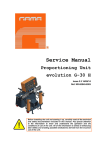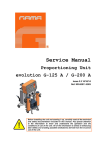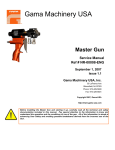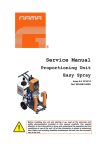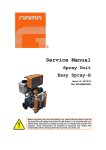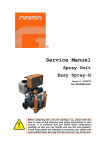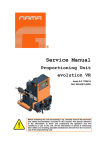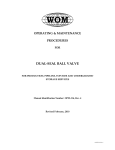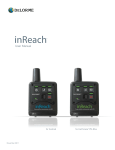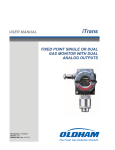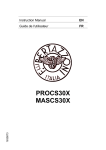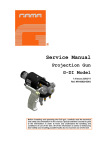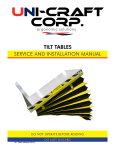Download G140 Service Manual
Transcript
Gama Machinery USA Evolution G-140 H Metering Unit Service Manual Ref # NR-00013-ENG January 1 2008 Issue 1.1 Gama Machinery USA, Inc. 55 LaFrance Ave Bloomfield, NJ 07003 Phone: 973-429-5600 Fax: 973-429-5601 Copyright 2007, Gama-USA http://www.gama-usa.com Before installing the unit and starting it up, carefully read all the technical and safety documentation included in this manual. Pay special attention to the information to know and understand the operation and the conditions of use of the unit. All of the information is aimed at enhancing User Safety and avoiding possible breakdowns derived from the incorrect use of the unit. Service Manual WARRANTY GARRAF MAQUINARIA, S.A. (hereinafter “GAMA”) provides this LIMITED WARRANTY (hereinafter “Warranty”) to the original purchaser (hereinafter “Customer”) covering this equipment and the original GAMA manufactured accessories delivered with the equipment (hereinafter “Product”) against defects in material or workmanship of the Product (hereinafter “Defect” or “Defective”) for a period of two (2) years from the date of first purchase as shown on the original GAMA invoice (hereinafter “Warranty Period”). If during the Warranty Period under normal use, the Product is suspected by Customer to be Defective in material or workmanship, it is Customer’s responsibility to contact GAMA and return the Product to GAMA as directed by GAMA, freight prepaid. If GAMA determines that the Product is Defective and that such Defect is covered by this Warranty, GAMA will credit Customer for the reasonable freight charges incurred by Customer in returning the Defective Product to GAMA, and GAMA (or its authorized agent) will, at GAMA’s option, repair or replace the Product, subject to the following: Original Invoice: The original invoice must be kept as proof of the date of first sale and the Product serial number. The Warranty does not cover any Product if the Original Invoice appears to have been modified or altered, or when the serial number on the Product appears to have been altered or defaced. Product Maintenance: It is the Customer’s responsibility to maintain the Product properly. See your maintenance schedule and owner’s manual for details. The Warranty does not cover an improperly maintained Product. Non-GAMA Components and Accessories: Non-GAMA manufactured components and accessories that are used in the operation of the Product are not covered by this Warranty. Such components and accessories shall be subject to the warranty offered to the Customer, if any, by the original manufacturer of such component or accessory. Other Warranty Exclusions: The Warranty does not cover any Product that GAMA determines has been damaged or fails to operate properly due to misuse, negligence, abuse, carelessness, neglect, or accident. By way of example only, this includes: • Normal wear and tear. • Improper or unauthorized installation, repair, alteration, adjustment or modification of the Product. • Use of heating devices, pumping equipment, dispensers, or other parts or accessories with the Product that have not been approved or manufactured by GAMA. • Failure to follow the operating instructions and recommendations provided by GAMA. • Cosmetic damage. • Fire, flood, “acts of God,” or other contingencies beyond the control of GAMA. THE WARRANTY DESCRIBED HEREIN IS THE EXCLUSIVE REMEDY FOR THE CUSTOMER AND IS IN LIEU OF ALL OTHER WARRANTIES, EXPRESS, IMPLIED, STATUTORY OR OTHERWISE, AND THE IMPLIED WARRANTIES OF MERCHANTABILITY AND FITNESS FOR A PARTICULAR PURPOSE AND ALL OTHER WARRANTIES ARE HEREBY DISCLAIMED. TO THE FULLEST EXTENT PERMITTED BY LAW, GAMA SHALL NOT BE RESPONSIBLE, WHETHER BASED IN CONTRACT, TORT (INCLUDING, WITHOUT LIMITATION, NEGLIGENCE), WARRANTY OR ANY OTHER LEGAL OR EQUITABLE GROUNDS, FOR ANY CONSEQUENTIAL, INDIRECT, INCIDENTAL, LOST PROFITS, SPECIAL, PUNITIVE OR EXEMPLARY DAMAGES, WHETHER TO PERSON OR PROPERTY, ARISING FROM OR RELATING TO THE PRODUCT, EVEN IF GAMA HAS BEEN ADVISED OF THE POSSIBILITY OF SUCH LOSSES OR DAMAGES. Non-Warranty Service by GAMA: If GAMA determines that the suspected Defect of the Product is not covered by this Warranty, disposition of the Product will be made pursuant to the terms and conditions of GAMA’s written estimate on a time and materials basis. Continuing Warranty for Products Repaired or Replaced under Warranty: Following the repair or replacement of a Product covered by this Warranty, such Product will continue to be subject to the original Warranty for the remainder of original Warranty Period or for three (3) months from the repair or replacement date, whichever is longer. No Rights Implied: Nothing in the sale, lease or rental of any Product by GAMA shall be construed to grant any right, interest or license in or under any patent, trademark, copyright, trade secret or other proprietary right or material owned by anyone; nor does GAMA encourage the infringement of same. 2/40 Issue 1.1 Ref. NR-00010-ENG Service Manual Exclusive Warranty: This writing is the final, complete, and exclusive expression of the Warranty covering the Product. Any statements made by GAMA, its employees or agents that differ from the terms of this Warranty shall have no effect. It is expressly understood that Customer’s acceptance of this Warranty, by performance or otherwise, is upon and subject solely to the terms and conditions hereof, and any additional or different terms and conditions proposed or expressed by Customer or anyone, whether in writing or otherwise, are null and void unless specifically agreed to in writing by an Officer of GAMA. 3/40 Issue 1.1 Ref. NR-00010-ENG Service Manual Warranty................................................................................................................. 2 Safety and Handling .............................................................................................. 5 Characteristics ...................................................................................................... 7 Principal Heating System.......................................................................................................................... 7 Hose Heating System................................................................................................................................ 7 Double Acting Opposed Piston Metering Pumps ..................................................................................... 7 Technical specifications ....................................................................................... 8 Electrical ................................................................................................................................................... 8 Mechanical................................................................................................................................................ 8 General Description .............................................................................................. 9 Control Panel ....................................................................................................... 12 Alarms .................................................................................................................. 16 Installation ........................................................................................................... 18 Start-UP Procedures ........................................................................................... 23 Shutdown Procedures ........................................................................................ 24 Cleaning ............................................................................................................... 25 Long Term Shutdown Procedures ..................................................................... 26 Troubleshooting .................................................................................................. 27 Heaters _________________________________________________________________ 28 Hose heating_____________________________________________________________ 30 Metering pumps __________________________________________________________ 32 Hydraulic unit ____________________________________________________________ 35 Maintenance......................................................................................................... 36 Heaters _________________________________________________________________ 37 Hydraulic unit ____________________________________________________________ 38 Metering pumps __________________________________________________________ 39 Inlet supply filters _________________________________________________________ 39 Isocyanate pump lubrication system___________________________________________ 40 4/40 Issue 1.1 Ref. NR-00010-ENG Service Manual All information provided in this Service Manual is assumed to be correct; although this does not constitute any implicit or explicit liability or guarantee. GAMA reserves the right at any time and without prior warning to make all improvements and modifications necessary to this Service Manual, in order to rectify any possible typographical errors, supplement the information contained or insert changes predicated by the performance or use of the unit. SAFETY AND HANDLING The evolution G-140 H series metering unit has been designed and manufactured in full compliance to the provisions of Machine Directive 89/392/CEE in its modified form and the National Regulations that transpose it. It also meets all European Directives concerning electromagnetic compatibility and electrical safety and the provisions of the Harmonised Norms that are applicable. This chapter contains important information on the safety, handling and use of the evolution G-140 H series metering unit. Before installing the unit and starting it up, carefully read all the technical and safety documentation included in this manual. Pay special attention to the information to know and understand the operation and the conditions of use of the unit. All of the information is aimed at enhancing User Safety and avoiding possible breakdowns derived from the incorrect use of the unit. WARNING! establishes information to alert on a situation that might cause serious injuries if the instructions are not followed. PRECAUTION! establishes information that indicates how to avoid damage to the unit or how to avoid a situation that could cause minor injuries. NOTE is relevant information on a procedure being carried out. Careful study of this manual will enable the operator to know the characteristics of the unit and the operating procedures. By following the instructions and recommendations contained herein, you will reduce the potential risk of accidents in the installation, use or maintenance of the unit; you will provide a better opportunity for incident-free operation for a longer time, greater output and the possibility of detecting and resolving problems fast and simply. Keep this Service Manual for future consultation of useful information at all times. If you lose this manual, ask for a new copy from your GAMA local distributor or directly contact Gama Machinery USA, INC. WARNING! The design of the evolution G-140 H series metering unit does not allow its use in potentially explosive atmospheres or to exceed the pressure and temperature limits described in the technical specifications of this manual. 5/40 Issue 1.1 Ref. NR-00010-ENG Service Manual When working with the unit, it is recommended that the operator wear suitable clothing and elements of personal protection, including, without limitation, gloves, protective goggles, safety footwear and face masks. Use breathing equipment when working with the machine in enclosed spaces or in areas with insufficient ventilation. The introduction and follow-up of safety measures must not be limited to those described in this manual. Before starting up the machine, a comprehensive analysis must be made of the risks derived from the products to be dispensed, the type of application and the working environment. To prevent all possible bodily harm caused by incorrect handling of the raw materials and solvents used in the process, carefully read the safety information provided by your supplier. Deal with the waste caused according to current regulations. Disconnect the unit from the power supply before carrying out any operation inside the electrical console. The electrical maintenance of the machine must only be performed by a qualified electrician. To avoid damage caused by the impact of pressurized fluids, do not open any connection or perform maintenance work on components subject to pressure until the pressure has been completely eliminated. Use suitable protection when operating, maintaining or remaining in the operating area of the unit. This includes, but is not limited to, the use of masks, protective goggles, gloves, shoes and safety clothing. The unit includes components that reach temperatures that are liable to cause burns. The hot parts of the unit must not be handled until they have cooled. To prevent serious harm by crushing or loss of limbs, do not work with the unit without the safety guards installed on all moving parts. Make sure that all of the safety protections are correctly reinstalled after all repair or maintenance work is completed. 6/40 Issue 1.1 Ref. NR-00010-ENG Service Manual CHARACTERISTICS The evolution G-140 H metering unit has been designed and built for the application of polyurea chemical systems, polyurethane foam chemical systems and some two-component epoxy systems. Principal Heating System Consists of two independent heaters without seals. Each heater has four 1250 W heating elements (1500 W optional), that give the unit a total power of 5000 W (6000 W optional), and the necessary control and safety components for precise operation of the system. Its singular configuration allows a temperature differential (ΔT) of 90º F and application temperatures of up to 194º F under normal conditions of ambient temperature. Hose Heating System Designed with a 3000 W isolation transformer that enables effective heating up to a total hose length of 310 feet. The system includes an innovative hose heating concept in which the copper heating element is spread evenly around the circumference of the hose, providing a uniform heating watt density and precise control of the product application temperature. This hose heating element design is extremely resistant to fatigue failure. 100% circumferential coverage produces the most homogenous distribution of heat available. Double Acting Opposed Piston Metering Pumps A pump line driven by a double rod hydraulic cylinder. The in line pump system with opposed piston pumps provides a constant volume and guarantees uniform pressures in both directions of pump movement. Different sized pumps allow for various volumetric ratios to be achieved (1:4 to 4:1) between the chemical components used in the process. 7/40 Issue 1.1 Ref. NR-00010-ENG Service Manual TECHNICAL SPECIFICATIONS Electrical Main voltage: _________________________________________________ 3x 230 V; 50/60 Hz Main voltage:_____________________________________________________ 1 x 230; 60 Hz Electrical consumption: ___________________________________________ 35A @ 3 x 230 V Electrical consumption*: __________________________________________ 43A @ 3 x 230 V Electrical consumption: ___________________________________________ 70A @ 1 x 230 V Electrical consumption*: __________________________________________ 80A @ 1 x 230 V Pre Heater power: _______________________________________________ (2 X 5 Kw) 10 Kw Pre Heater power (optional): _______________________________________ (2 X 6 Kw) 12 Kw Hose Transformer Power: ___________________________________________________ 3 Kw Electrical Motor Power: _______________________________________________ 2.5 Kw / 3hp * Machine fitted with two 6 Kw heaters (optional) Inside the console, there is a terminal strip for connecting the main power (wire not supplied) to the unit. The electrical connection of the unit must only be carried out by a qualified electrician. Mechanical Maximum working pressure (with pumps 1.2): ________________________________ 2000 psi Maximum working pressure (with pumps 0.8): ________________________________ 3000 psi Maximum production ratio 1:1 (with pumps 1.2): ______________________________20 lb/min Maximum production ratio 1:1 (with pumps 0.8): ______________________________ 1.4 gpm Minimum production:___________________________________________________ 2.2 lb/min Maximum hose length: ____________________________________________________ 310 ft Recommended compressor: _________________________________________________ 3 Hp Approximate weight (hydraulic tank empty): ___________________________________ 418 lbs Approximate weight (hydraulic tank full):______________________________________ 594 lbs Dimensions: ______________________________________________47in W x 36in L x 28in H 8/40 Issue 1.1 Ref. NR-00010-ENG Service Manual GENERAL DESCRIPTION 9/40 Issue 1.1 Ref. NR-00010-ENG Service Manual Figure 1. General Description. 1. Control Panel Controls and regulates the operation of the unit. 2. Isocyanate Metering Pump Meters the Isocyanate. 3. Polyol Metering Pump Meters the Polyol. 4. Isocyanate Pre Heater Heats the Isocyanate to the pre-set temperature. 5. Polyol Pre Heater Heats the Polyol to the pre-set temperature. 6. Hose Heating Transformer Supplies the required voltage for heating the hoses. 7. Hydraulic Pressure Gage Indicates the pressure in the hydraulic drive system. 8. Isocyanate Pressure Gage Indicates the pressure in the Isocyanate system. 9. Isocyanate Safety Pressure Switch Deactivates the directional valve in the event of excessive pressure in the Isocyanate system. 10. Isocyanate Temperature probe Provides information on the temperature of the Isocyanate. 11. Polyol Pressure Gage Indicates the pressure in the Polyol system. 12. Polyol Safety Pressure Switch Deactivates the directional valve in the event of excessive pressure in the Polyol system. 13. Polyol Temperature Probe Provides information on the temperature of the Polyol. 14. Hydraulic Pressure Regulator Allows the pressure of the hydraulic system to be increased or decreased. Turn clockwise to increase the pressure and counterclockwise to reduce it. In order to regulate the pressure of the hydraulic system, the NORMAL or RETRACT key must be activated. 10/40 Issue 1.1 Ref. NR-00010-ENG Service Manual 15. DIP Selectors TPC Probes This allows the hose heating control mode to be selected, depending on whether they include a TCS probe for direct temperature control or not. To make a correct selection of the control mode, consult page 10, point 2, of this manual. 16. DIP Selector Control Units This allows the temperature units to be selected that will be shown on the displays of the control panel. Set to EU for the temperature to be shown in degrees Celsius (ºC) or to USA for the temperature to be shown in degrees Fahrenheit (F). 17. DIP Motor Selector This allows the operation of the hydraulic system to be activated or deactivated. The adjustment is carried out in factory depending on the machine model. 11/40 Issue 1.1 Ref. NR-00010-ENG Service Manual CONTROL PANEL Figure 2. Control Panel The Control Panel allows the optimum working conditions to be selected and set, depending on the characteristics and requirements of the products to be dispensed. Using the MODE key, the different control parameters may be entered. The parameter display will flash for a few seconds to allow the change of this value by pressing the UP / DOWN keys. Once the change is made, press the MODE key once more for the new value to be entered into memory and to select the next parameter for setting. The modification mode will be interrupted automatically after 3 seconds without activity on the keyboard. The parameters that may be selected and displayed are the following: • Hose temperature in automatic control mode (maximum 90º C / 194 F) • Hose heating power (maximum 55 Amps) • Isocyanate heater temperature (maximum 90ºC / 194 F) • Polyol heater temperature (maximum 90ºC / 194 F) • Total number of cycles to be made • Number of cycles made 12/40 Issue 1.1 Ref. NR-00010-ENG Service Manual 1. Main Power Switch Turns the electric supply to the control panel on and off. It must be turned ON for any operation to be performed with the unit. When turned ON, the green pilot at the top of the switch will come on. 2. Hoses The hose heating control may be automatic (optional) when using the TCS probe for direct temperature control, or manual when not using the TCS probe. The control mode must be established with two DIP selectors in the printed circuit. Set the “HOSE TEMP” DIP to ON if the Isocyanate hose includes a TCS probe; or set the one DIP selector to OFF if the Isocyanate hose does not have a TCS probe or if this is not operative due to breakdown or for any other reason. The automatic control mode will show the temperature of the Isocyanate hose (ISO) on the corresponding display. In manual control mode, only the selected amps will be shown. HOSE TEMP ON with TCS probe in the hose HOSE TEMP OFF manual control To select the temperature when the unit is working in automatic control mode, press the MODE key until the temperature flashes, select the required temperature by pressing the UP/DOWN keys and press the MODE key once more to enter the selected value into memory. Do the same process to select the Amps. When the unit is working in automatic mode, the value of the power must be set between 40 and 45 Amps. If the control probe is not operative, the temperature display will show the symbol (---) and the heating will be turned off. The lower pushbutton activates turn on or off the heating of the hose of the product. The pushbutton has a led that lights when the heating is working; if the led flashes, it indicates that the heating is activated but fails to heat. AT start-up, the hose heat set point is not maintained in memory and must be reset after each activation of the CONTROL POWER key. To select the hose power when the unit is working in manual heating control mode, press the MODE key until the amperage flashes, press the UP / DOWN keys to enter the number of amps required and press the MODE key once more to enter the value into memory. 13/40 Issue 1.1 Ref. NR-00010-ENG Service Manual Refer to the table shown below to select the power that is required to reach the application temperature: 30 A 35 A 40 A 45 A 50 A 38º C 48º C 60º C 75º C 90º C 100º F 118º F 140º F 167º F 194º F 3. Heaters The display shows the temperature in the Isocyanate heater (ISO) and the temperature in the Polyol heater (RESIN). To enter new temperature values, press the MODE key until the respective temperature flashes; select the required temperature by pressing the UP/DOWN keys and press the MODE key to enter the value into memory. The pushbuttons turn on or off the heater of each product. Each pushbutton has a led that lights steady when the heater is on; if the led flashes, it indicates that the heater is at the preset temperature. If excessive pressure is caused in the circuit of either product, the heating will stop working momentarily until the excessive pressure disappears. If the temperature control probe stops working, the temperature display will show the symbol (---) and the heater will automatically be turned off. AT start-up, the heater set point is not maintained in memory and must be reset after each activation of the CONTROL POWER key. 4. Mode Key Allows access to change the different control parameters. 5. Up / Down Keys Allows the value of each of the parameters to be increased or decreased. 6. Counter Indicator displays the cycles used and the cycles remaining from the preset. The cycle counter is incremental and may be reset by simultaneously pressing the UP / DOWN keys. The system allows pre-selecting the required number of working cycles so that the unit will automatically stop when it reaches this number. To enter the number of cycles to reach automatic shutdown, press the MODE key until the cycle meter flashes, select the number of cycles with the UP / DOWN keys and press the MODE key to enter the value into memory. When the unit starts, the cycles used will be deducted from the pre-selected cycles until the total number of cycles requested is completed. Once completed, the display will show zero and the unit will automatically stop. The cycle meter display will alternate every two or three seconds to show the cycles used (totalizer) and the cycles remaining (pre-set). The cycles remaining will be shown by the Minus sign (-XXXXX). The counter display will also show any alarm warnings resulting from faults. 7. Power Control Key Pushbutton turns on and off the control voltage to the electrical circuit of the heaters and hoses. When the key is on, the led in its center will come on. It may be turned off at will by pressing the key once more, or automatically if an alarm is caused due to excessive temperature in the heaters (alarms 6 and 7) or due to excessive current in the heating system of the hoses (alarm 9). 14/40 Issue 1.1 Ref. NR-00010-ENG Service Manual 8. Motor Key Pushbutton turns on and off the hydraulic motor. When the key is active, the led in its centre will come on. This may be turned off at will by pressing the key once more, or automatically in the event of overload in the hydraulic motor (alarm 8). 9. Normal Key Activates the normal operation of the machine. When the key is active, the led in its center will come on. 10. Retract Key Sets the piston rod of the Isocyanate metering pump to the retract position and prevents the crystallization of Isocyanate on the piston rod. Press the RETRACT key every time the unit is stopped by the operator. When the key is active, the led in its center will come on. 11. Direction Indicator Pilot Light Indicates the direction of movement of the metering pumps. If excessive pressure is caused in the system, the pilot lights will be turned off and alarms 3 and 4 will be active. The functions of the NORMAL and RETRACT keys will remain active. 15/40 Issue 1.1 Ref. NR-00010-ENG Service Manual ALARMS When the unit has faults caused by conditions affecting its correct operation, an audible alarm will sound and a fault number will show on the COUNTER display. The system does not allow an alarm to be reset until the fault causing the alarm has been corrected. After resetting, the MODE key must be pressed. The procedures recommended to determine the possible causes activating the alarms are indicated in the following: 1. Maneuvering Voltage under 170 V • Check the electrical supply connections. • Check the transformer thermal limit switch. Maneuvering Voltage over 270 V • Check the electrical supply connections. Excessive ISO Pressure (deactivates the directional valve and the heating system) 2. 3. • Check the product pressure. • Check the number 10 led of the printed circuit: it must be lit. • 4. Check the over pressure safety switch. Excessive POL Pressure (deactivates the directional valve and the heating system) • Check the product pressure. • Check the number 11 led of the printed circuit: it must be lit. • 5. Check the over pressure safety switch. Excessive ISO temperature (deactivates the POWER CONTROL) • Check the heater heating system. • Check the connections of the safety thermostat and allow it to cool so that it makes an automatic reset. • 6. Check the number 12 led of the printed circuit: it must be lit. Excessive POL temperature (deactivates the POWER CONTROL) • Check the heater heating system. • Check the connections of the safety thermostat and allow it to cool so that it makes an automatic reset. • Check the number 13 led of the printed circuit: it must be lit. Fault key (it only turns on when the machine is connected to the main power supply) • Check the keyboard. Fault in Hose Heating System (deactivates the POWER CONTROL) • Replace the faulty triac. Motor fault (the motor stops) 7. 8. 9. • Check the amperage draw on the hydraulic motor. • Check the electrical connection of the hydraulic motor. • Check the number 15 led of the printed circuit: it must be turned off. 16/40 Issue 1.1 Ref. NR-00010-ENG Service Manual 000000 Cycle Pre-selection made (deactivates the directional valve) • Press the MODE key to reset the counter • Set the cycle selector to zero. Disconnect the unit from the main power supply before working on the inside of the electrical console. The electrical maintenance of the machine must only be performed by a qualified electrician. 17/40 Issue 1.1 Ref. NR-00010-ENG Service Manual INSTALLATION PRECAUTION! Use suitable protection and follow the recommendations in the safety information provided by product suppliers when installing or working with the unit. GAMA provides a series of tools and accessories necessary for assembling the machine. The kit is made up of the following elements: 12” spanner, 6” spanner, universal pliers, screwdriver, allen keys, socket, oiling unit, tube of grease, magnet holder tools, pin extractor, component manual and service manual. Inside the console there is a terminal strip for connecting the principal electrical wire (not supplied) to the unit. The electrical connection of the unit must only be carried out by a qualified electrician. NOTE: To ensure that the unit works correctly, the electrical supply must meet the specifications indicated on page six of this manual and appearing on the machine specifications plate. Follow the recommended procedure in the indicated order to install the unit: a) Insert the main power cable by passing it through the wire stop at the bottom of the electrical console and connect as shown in the diagram. Make sure the power cable is disconnected from the mains source before connecting it to the terminal strip in the console. b) Load 80 litres (20 gal) of hydraulic fluid into the tank of the unit. The oil must be of the characteristics and specifications of DIN 51524 standard, sections 1 and 2 (for example. ISO VG 46). NOTE: Do not fill the tank to maximum capacity; use the visual level indicator on the tank to make sure the amount of oil is not more than 80% of its maximum capacity. c) Check the level of the oil in the case of the hydraulic pump: remove the plug from the top of the pump case and check that the oil level reaches to the top of the case. Add oil if necessary and refit the plug. 18/40 Issue 1.1 Ref. NR-00010-ENG Service Manual d) Fill the lube reservoir of the Isocyanate pump with DOP. It is not necessary to prime the system. e) Connect the hoses of the products to the outlets of the respective heaters (the Isocyanate hose to the Isocyanate heater and the Polyol hose to the Polyol heater). NOTE: The product hoses have been identified with red (Isocyanate) and blue (Polyol), enabling them to be rapidly distinguished. To avoid errors in connecting the coupling connectors of the Isocyanate and Polyol hoses, the connectors are of different sizes to make it impossible for connections to be swapped. The hoses receive vacuum drying treatment and are supplied interconnected at the ends to prevent them from absorbing moisture. Do not separate them until they are going to be installed in the unit. The transformer offers the option of connecting to a 45 V output voltage valid for a total hose length of up to 160 ft, or an output voltage of 75V for hose lengths of over 160 ft; connect to one output voltage or the other depending on the total hose length installed. Before starting up the unit, make sure that the connection made in the factory adapts to the total length of hose installed. If you add or eliminate sections of hose, make sure the output voltage of the transformer to which it is connected is suitable for the resulting total length. Otherwise, change the connection. 19/40 Issue 1.1 Ref. NR-00010-ENG Service Manual f) Connect the “fast lock” of the transformer output to the “fast lock” of the product hoses and assure the connection with a clip. g) Connect the rest of the product hoses to complete the required length. Remember that the hoses are identified with red (Isocyanate) and blue (Polyol). NOTE: It is very important to correctly perform the connection between the hoses to avoid possible product losses. h) Install the TCS between the last section of product hose and the final section connected to the gun. Carefully straighten the sensor wire, inserting it in the Isocyanate hose. Connect the ground wire of the gun hose to the sensing unit. i) Make the connection between the output wire of the TCS and that from the machine. j) Carefully strip the wire insulation back 1/2 in (12mm) k) Remove the nylon safety plug and loosen the socket head set screw l) Insert the wire all the way into the nylon end connector so that the insulation butts up against the inside face of the end connector m) Tighten the set screw using a 1/8 allen wrench n) Insert the safety plug and snug it to the set screw using the 1/8 allen wrench (DO NOT OVERTIGHTEN) o) Tape in place on the hose to make a secure bundle NOTE: a good practice is to add some dielectric grease to the ID of the connector Nylon Safety Plug Socket Head Set Screw:1/4-20x 1/4 #6 Stranded Wire 1/2in 12mm Hose Heat Connector Body 20/40 Wire Terminal Issue 1.1 Ref. NR-00010-ENG Service Manual NOTE: To protect the TCS sensor, you must pay special attention not to kink or excessively bend the hoses. Do not roll up the hoses with a radius of under one meter / 4 feet. a) Connect the air hoses. b) Connect the hoses to the connectors of the coupling block of the gun, making sure that the manual valves are closed. Having performed the above operations, you must note the direction in which the motor turns. To make sure that it is turning clockwise, do the following: a) Turn the hydraulic pressure regulator counter clockwise. b) Turn the general switch ON. The top pilot light will come on. c) Press the POWER CONTROL key. d) Go to the side of the machine to be able to see the motor fan. Press the MOTOR key to start the motor and press it again to stop it. Check that the blades of the fan are turning clockwise, otherwise turn the general switch OFF and disconnect the machine from the source of electrical supply. e) Open the console of the control panel and change the position of two of the three wires of the electrical connection of the unit. Check the turning direction once more. Proceed to install the transfer pumps paying special attention to connect each pump to “its” respective product, as changing the pumps would cause a reaction in the products inside them and make them useless. Identifying each pump with a tape of the same color as that of the hoses (blue for the Polyol pump and red for the Isocyanate pump) might be a good method for avoiding errors in connection. Do the following steps to install the pumps: a) Make sure that the inlet valves of the products to the unit are closed. b) Connect one end of the Polyol hose (¾” thread) to the Polyol valve and the other end to the transfer pump of the same product. c) Connect one end of the Isocyanate hose (½” thread) to the Isocyanate valve and the other end to the transfer pump of the same product. d) Connect the air hose to the transfer pumps. NOTE: To avoid errors in connection, the coupling connectors of the Isocyanate and Polyol hoses are of different sizes, which makes it impossible to swap connections. e) Install the unit ground connection. The movement of the product inside the hose can cause static electricity and produce electrical discharges. 21/40 Issue 1.1 Ref. NR-00010-ENG Service Manual Before using the unit, the residual air and oil from factory testing must be eliminated. To purge the whole circuit, proceed as follows: a) Pressurize the transfer pumps and open the inlet ball valves. Make sure there are no leaks. b) Turn the hydraulic pressure regulator counter clockwise. c) Turn the general switch ON. The top pilot light will come on. d) Press the POWER CONTROL key. e) Hold the coupling block with the outlet of each product in separate vessels and open the manual valves of each product. f) Press the MOTOR key. g) Press the NORMAL key. The led will light h) If necessary, increase the hydraulic pressure by turning the regulator clockwise until the product pumps begin to move slowly. i) Allow the materials to come out of the coupling block until the residual oil and the air bubbling has disappeared completely. j) Close the manual valves of each product and clean the coupling block of the remains of product. k) Slowly increase the hydraulic pressure to check for product leaks in the hose joints. Retighten if necessary and tape the connectors to protect them from possible damage. l) Press the NORMAL key. The led will go out. m) Place the gun in the coupling block. 22/40 Issue 1.1 Ref. NR-00010-ENG Service Manual START-UP PROCEDURES Follow the recommended procedure in the indicated order. PRECAUTION! The start-up procedures assume that all of the necessary adjustments have been correctly performed. a) Check the state of the DOP plasticizing oil in the lubrication tank of the Isocyanate pump. Change the oil if you see changes in the color or signs of solidification. b) Check the hydraulic oil level. Add oil if the level is low. c) Make sure that the chemical products to be processed are above the minimum temperature required to be supplied to the unit through the transfer pumps. Ask your product supplier for information on the minimum supply temperature. d) Check the input filters of the products. Clean them if necessary. e) Pressurize the two transfer pumps and open the inlet valves of the products to the unit. f) Turn the general switch ON. The top pilot light will come on. g) Press the POWER CONTROL key. The led will light. h) Press the ISO key under the HOSES display. The led will light in the center of the key. In machines fitted with two transformers, the ISO and RESIN keys must be pressed. The two leds will light. i) Press the ISO and RESIN keys under the HEATERS display when the products in the hoses reach the working temperature. The two leds will light. PRECAUTION! To avoid excessive pressure in the heated hoses, wait for the hose heat to reach the required temperature before starting up the hydraulic system. j) Press the MOTOR key. The led will light. k) Press the NORMAL key. The led will light. One of the direction indicator lights will come on and the dosing pumps will begin to move. Using the hydraulic pressure regulator, adjust the required pressure and check the pressure of each dosing pump on their respective gages on the machine outlet. The pressures must be practically the same and remain constant. The directional indicator lights must remain with one on and the other out. The lit lamp indicates the direction of movement of the pumps. l) If the pressure fluctuates on either stroke, consult the fault section before continuing. m) Connect the air supply to the gun; open the manual valves of each product; make a test projection and check the pressures on the product gages. If the projection test is correct and the pressures remain equal, proceed with the application 23/40 Issue 1.1 Ref. NR-00010-ENG Service Manual SHUTDOWN PROCEDURES Follow the recommended procedure in the indicated order for machine shut down when work is stopped for the day. a) Press the RETRACT key. The led will light. b) Use the gun to project into a waste container until the Isocyanate metering pump is in the retract position and the pressure begins to fall. PRECAUTION! To avoid possible seal weepage and the early failure of the pump seals, the pressure must not be reduced to zero. It is recommended to keep the system with a minimum pressure of 30 bar (400 psi) to extend the life of the seals. c) Press the MOTOR key. The led will go out. d) Press the ISO and RESIN keys under the heater temperature display. The two leds will go out. e) Press the ISO key under the HOSES display. The led will go out. In machines fitted with two transformers, the ISO and RESIN keys must be pressed. The two leds will go out. f) Press the POWER CONTROL key. The led will go out. g) Turn the general switch OFF. The top pilot light will go out. h) Close the inlet ball valves. i) Close the supply to the transfer pumps. j) Disconnect the air supply to the transfer pumps k) Close the manual valves of the coupling block and remove the gun to perform the corresponding maintenance. 24/40 Issue 1.1 Ref. NR-00010-ENG Service Manual CLEANING PRECAUTION! The unit includes components that reach temperatures that are liable to cause burns. The hot parts of the unit must not be handled until they have cooled. To avoid possible contamination, the circuits of the unit must previously be cleaned (pumps, heaters and hoses) whenever applications have to be made that require a change of components. Follow the recommended procedure in the order indicated to perform the cleaning when you have to change the components of the system: a) Place two drums of DOP cleaning agent close to the machine. b) Dismantle the gun and leave the coupling block connected to the hoses. c) Remove the transfer pumps of the product drums and place them in the drums of the DOP cleaning agent. d) Place a vessel under the coupling block to gather up the products contained inside the machine. e) Open the manual valves on the coupling block and press the MOTOR and NORMAL keys to start up the metering pumps. f) Allow the products to come out until you see that only DOP cleaning agent comes out free of impurities. g) Close the valves on the coupling block and deactivate the MOTOR and NORMAL keys. h) Place the transfer pumps in the drums of the new products. i) Place a vessel under the coupling block to collect the DOP cleaning agent. j) Open the valves on the coupling block and press the MOTOR and NORMAL keys to start up the dosing pumps. k) Allow the DOP cleaning agent to come out until you see that only the new products come out. l) When the products come out without the contamination produced by the effect of the DOP cleaning agent, the cleaning process is complete and you can proceed as normal. 25/40 Issue 1.1 Ref. NR-00010-ENG Service Manual LONG TERM SHUTDOWN PROCEDURES PRECAUTION! The unit includes components that reach temperature that are liable to cause burns. The hot parts of the unit must not be handled until they have cooled. When you plan to shut down the machine for more than five weeks, the products contained in the machine must be replaced by DOP plasticizing agent. Follow the recommended process in the order indicated, to change the products for DOP oil: a) Place two drums of DOP cleaning agent close to the machine. b) Dismantle the gun and leave the coupling block connected to the hoses. c) Remove the transfer pumps of the product drums and place them in the drums of the DOP cleaning agent. d) Place a vessel under the coupling block to gather up the products contained inside the machine. e) Open the manual valves on the coupling block and press the MOTOR and NORMAL keys to start up the dosing pumps. f) Allow the products to come out until you see that only DOP cleaning agent comes out free of impurities. g) Deactivate the MOTOR and NORMAL keys, close the valves on the coupling block, turn the general switch OFF, disconnect the supply system of the transfer pumps and the process is finished. The metering pumps, the heaters and the hoses must be full of DOP plasticizing oil. Never leave the machine or the hoses empty of product or DOP plasticizing oil. 26/40 Issue 1.1 Ref. NR-00010-ENG Service Manual TROUBLESHOOTING The evolution G-140 H unit has been designed and built to withstand severe working conditions with a high degree of reliability, provided it is used suitably. This chapter contains information on possible faults that may prevent the continuation of work with the unit. The information provided must serve as guideline to detect and resolve the large majority of the problems before calling for the assistance of the authorized distributor or GAMA technical service. In any case, feel free to contact the technical assistance service of Gama Machinery USA., where a qualified technician will advise you on whatever you may need. All repairs performed by unqualified personnel or the use of spares other than originals may cause damage to the unit and put the operator at risk. To prevent possible bodily harm caused by incorrect handling of the raw materials and solvents used in the process, carefully read the safety information provided by your supplier. Deal with the waste caused according to current regulations. Disconnect the unit from the power supply before carrying out any operation inside the electrical console. The electrical maintenance of the machine must only be performed by a qualified electrician. To avoid damage caused by the impact of pressurized fluids, do not open any connection or perform maintenance work on components subject to pressure until the pressures have been completely eliminated. Use suitable protection when operating, maintaining or remaining in the operating area of the unit. This includes, but is not limited to, the use of masks, protective goggles, gloves, shoes and safety clothing. The unit includes components that reach temperature that are liable to cause burns. The hot parts of the unit must not be handled until they have cooled. To prevent serious harm by crushing or loss of limbs, do not work with the unit without the safety duly installed on all moving parts. Make sure that all of the safety protections are correctly fitted after all repair or maintenance work. 27/40 Issue 1.1 Ref. NR-00010-ENG Service Manual Heaters ¡WARNING! Before resolving any kind of defect, make sure all of the pushbuttons are off, that the general switch is in shutdown position and that the unit is disconnected from the power supply. Never handle the inside of the control panel with the unit connected to the power supply. The heaters are components that reach high temperatures; wait until they have cooled before handling. NOTE: The thermostat is a safety element in contact with the heater. If the temperature exceeds 194º F the thermostat will cut off the electric supply by deactivating the POWER CONTROL. The thermostat will not reset until the temperature in the heater is below 194º F. If the temperature in the Isocyanate heater or the Polyol heater is over 90º C (194º F), an alarm will be activated and the corresponding number will be shown on the control panel (5 for Isocyanate and 6 for Polyol). Follow the recommended procedure in the order indicated, to try to solve the problem and avoid costly repairs. Make sure all the automatic switches and control elements are in the correct working position before determining the existence of a fault. PROBLEMS SOLUTIONS The heater fails to heat, the pushbutton led is lit. The heater display shows the symbol (---) 1-2-3 4 SOLUTIONS 1. Static Relay This determines that the static relay is not working when all of the previous checks have been correct. 28/40 Issue 1.1 Ref. NR-00010-ENG Service Manual 2. Heating Resistances Each heater has four 1250 W elements connected in parallel, which give the system a total power of 5000 W. If under normal conditions of ambient temperature, it is not possible to reach the temperature required in two or three minutes, it is possible that one or several heating elements are not working. To check the state of the element, proceed as follows: With the general switch turned off, use a tester to check that the total resistance of all the elements is 10.5 Ohms; a higher value would indicate that one or several of the elements are faulty. Disconnect them and check that the individual value of each element is 42 Ohms. Under extreme environmental conditions, the heater might be affected and fail to reach the required temperature. In this case, put the unit in a more favorable place, or use an auxiliary heating system. 3. Automatic Switch This protects the elements against any possible change in voltage. With the general switch turned off, open the control panel and make sure the switch is activated (see electrical diagram), otherwise activate it. 4. Temperature The control panel automatically detects any fault in the operation of the temperature. If the fault occurs, replace the probe, paying special attention not to damage it when assembling. The probe must be in firm physical contact with the element. 29/40 Issue 1.1 Ref. NR-00010-ENG Service Manual Hose heating WARNING! Before resolving any kind of defect, make sure all of the pushbuttons are off, that the general switch is in shutdown position and that the unit is disconnected from the power supply source. Never handle the inside of the control panel with the unit connected to the power supply. The hoses can reach high temperatures; wait until they have cooled before handling. If a fault occurs in the heating system of the hoses, an alarm will be activated and the number 9 will be shown on the control panel. Follow the recommended procedure in the order indicated, to try to solve the problem and avoid costly repairs. Make sure all the automatic switches and control elements are in the correct working position before determining the existence of a fault. PROBLEMS SOLUTIONS The hose is hot, but fails to reach the selected temperature. The hose is not hot; the pushbutton led is lit. 1-2-7 2-3-4-5 Only the sections of the hose closest to the unit are heated. 5 The hose display shows the symbol (---). 6 The automatic switch is triggered. 3 SOLUTIONS 1. Hose Length The evolution G-140 H has been designed to work with a maximum hose length of 310 ft. A longer length will render the heating capacity less effective. Under extreme ambient conditions, the hose heating system may be affected and fail to reach the required temperature. 2. Hose Transformer The transformer offers the option of connecting to a 45 V output voltage valid for the connection of hose sections with a total length of up to 160 ft, or an output voltage of 90 V, for connecting hose lengths of over 160 ft; connect to one or the other position depending on the total hose length installed in the machine. If the connection is performed incorrectly, the hoses will not reach the required temperature. 3. Automatic Switch This protects the secondary circuit of the transformer. The switch is located on the front of the transformer; make sure it is activated, otherwise activate it. Replace it with one of equal amperage if the switch fails to work correctly. PRECAUTION! The replacement of the automatic switch with another of different characteristics may cause damage to the equipment and put the operator at risk. 30/40 Issue 1.1 Ref. NR-00010-ENG Service Manual 4. Triac This determines that the triac is faulty when all of the previous checks have been correct. Replace the triac if is fails to work correctly. 5. Hose Heating Components With the general switch turned off, make sure the hose connections and the electrical connections between the hoses and the unit are correct and tight. If the connections are correct and the hoses do not heat up, check section by section to locate the connection that is at fault. Proceed as follows: Disconnect the unit from the power supply by deactivating the general switch and start to check the hose section closest to the gun. Remove the “Fast Lock” connector, and make a “bridge” on the connection immediately before. Restore the power supply, press the POWER CONTROL key and the ISO and RESIN keys under the HOSES display. If the heating works, the problem will be in the last section of hose. Replace it. If not, do the following. Disconnect the unit from the power supply, remove the “Fast Lock” connector from the last section of hose and make a “bridge” on the connection immediately before. Restore the power supply, press the POWER CONTROL key and the ISO and RESIN keys under the HOSES display. If the heating works, the problem will be in the last but one section of hose. Replace it. If not, repeats steps c) and d) until you find the point of the fault. 6. TCS Temperature Control The control panel automatically detects any fault in the operation of the temperature sensor. To determine whether the fault is being caused by the sensor itself or by a faulty connection, do the following: disconnect the TCS from the hose at the gun end, without removing any other connection, connect it directly to the machine output socket; if the control is re-established, check the connections of the TCS wires in the intermediate hose sections, otherwise, replace the TCS 7. Hose Heating Temperature Adjustment The hose heating system maintains the temperature of the products exiting the heaters, which is why the value set for the temperature of the hoses must be the same as that selected on the heater display. 31/40 Issue 1.1 Ref. NR-00010-ENG Service Manual Metering pumps WARNING! Before resolving any kind of defect, make sure all of the pushbuttons are off, that the general switch is in shutdown position and that the unit is disconnected from the power supply source. Never handle the inside of the control panel with the unit connected to the power supply. The metering pumps are components that work under pressure; do not open any connection or perform repair or maintenance work on components subject to pressure until all of the pressures have been completely eliminated. If excessive pressure is caused in the Isocyanate circuit or the Polyol circuit, an alarm will be activated that will be shown on the control panel (3 for the Isocyanate and 4 for the Polyol). Follow the recommended procedure in the order indicated, to try to solve the problem and avoid costly repairs. Make sure all the automatic switches and control elements are in the correct working position before determining the existence of a fault. PROBLEMS SOLUTIONS The pumps fail to maintain the pressure when the unit is shut down. 1 There are pressure differences between the metering pumps. 1-2-3 There is cavitation in the metering pump. 1-2-3 The metering pumps do not change direction. The metering pumps fail to move and the direction indicator lights are out. The movement of the metering pumps is erratic. 4 4-5 4 SOLUTIONS 1. Loss in the Valve Ball Observe the pressure gages to identify which pump fails to maintain the pressure and check the direction indicator light to determine in which direction the pump fails to maintain the pressure. If the lit lamp is the left hand one and the pressure is lost in the Polyol pump, check the discharge valve ball of the Polyol pump; or check the inlet valve ball of the Isocyanate pump, if the pressure loss is caused in the Isocyanate pump. If the lit lamp is the right hand one and the pressure is lost 32/40 Issue 1.1 Ref. NR-00010-ENG Service Manual from the Polyol pump, check the inlet valve ball of the Polyol pump; or check the discharge valve ball of the Isocyanate pump, if the pressure is lost from the Isocyanate pump. Proceed as follows to check the valve balls: a) Disconnect the machine from the power supply and close both inlet ball valves and the supply system to the transfer pumps. b) Depressurise the metering pump and remove the corresponding valve ball. c) The loss from the valve ball is usually caused by foreign particles that prevent the perfect coupling of the ball with the ball seat. Clean the ball and the seat and make sure there are no faults from knocks, marks or scratches to the seat or the ball. If cleaning fails to resolve the problem or any fault is observed, replace the seat and the ball. 2. Decompensated Pressures Pressures are decompensated when there is an obstruction in the hose or in the gun that prevents one of the components from leaving freely through the gun chamber when it is projected, or when a problem in the pumping system prevents one of the components reaching the gun in the required amount. It is relatively easy to identify which component is problematic if we bear in mind that the chemical components used in the polyurethane foaming are of a different color. By observing the color of the material that leaves the gun, we can determine which component is missing. To determine whether the decompensation is caused as a result of an obstruction or as a consequence of a problem in the pumping system, project with the gun, observe the pressure indicated on the corresponding pressure gage to the missing component and compare it with the pressure indicated by the gage to the other component: if the pressure of the missing component is higher, the decompensation is the result of an obstruction, if the pressure is lower, the decompensation is the consequence of a problem in the pumping system. 3. Cavitation Cavitation occurs when the metering pump requires a larger volume of material than that supplied by the feeding system, causing the formation of a vacuum in the inlet of the metering pump. The causes of cavitation are the following: a) The transfer pump fails to supply the necessary volume. The problem might be in the pump not meeting the required specifications, in the lack of air supply to the pump or that the pump is faulty. A pump is recommended with a ratio of 2:1 for transferring the Isocyanate and a supply hose with an interior diameter of at least 3/4 in. b) High viscosity. The polyurethane foaming systems normally require a minimum transfer temperature of 55 F; at lower temperatures, the product increases its viscosity, making the pumping more difficult. When the ambient conditions prevent the products from being maintained at a minimum temperature of 52º F auxiliary heating elements must be used to condition the products as the minimum temperature required for the transfer. c) The product inlet filter is obstructed (see Maintenance). d) The inlet valve ball has leaks as a result of wear or possible faults in the ball or the closing surface of the seat, which means that part of the material supplied returns to the supply tank and that the metering pump supplies a smaller volume of material in the discharge cycle, causing an incorrect ratio. 33/40 Issue 1.1 Ref. NR-00010-ENG Service Manual 4. Fault in the Reversing Switch The metering pump system has a plate that activates the reversing switches to carry out the change of direction. The most common cause of the fault is the deformation of the plate or the entry of a foreign body preventing the plate from making contact with the micros. A fault in the movement of the directional valve will cause the activation plate to pass the micro and not make the change of direction. Proceed as follows to solve this problem: a) Determine the direction in which the plate must move; this depends on which micro has been passed. b) Locate the slide for the manual activation of the directional valve in the hydraulic distributor: this is located on the same side of the machine towards which the activation plate must work. c) Turn the general switch ON, press the POWER CONTROL key and the MOTOR key. With the manual valves of the coupling block open, point the gun at a waste container. d) Press the manual slide of the directional valve and hold it until the activation plate is centred between the two run end micros. e) If when pressing the slide, it moves freely, the excess run is due to an electrical problem. Press the MOTOR key and the NORMAL key; press the run end micros and check whether the reels are changed and the direction indicator lights: if the reels are not changed or the direction indicator lights fail to come on, there is an electrical problem in the run end micro or in the reels of the directional valve. 5. Over Pressure Safety Switch Each metering pump is protected by a safety pressure switch factory set to limit the pressure depending on the size of the pumps installed in the unit. The limit pressure set in the factory is 2000 psi. When the limit pressure is reached, the pressure switch interrupts the electrical supply to the directional valve, stopping the pumps. When the pumps stop, the direction indicator lights will go out and an alarm will be activated that will be shown on the control panel (3 if the excess pressure is caused in the Isocyanate circuit or 4 if it is caused in the Polyol circuit). When the pressure reaches lower values than the established limit, the metering pumps will restart. However, the causes of the excess pressure must be determined and corrected. 34/40 Issue 1.1 Ref. NR-00010-ENG Service Manual Hydraulic unit WARNING! Before resolving any kind of defect, make sure all of the pushbuttons are off, that the general switch is in shutdown position and that the unit is disconnected from the power supply. Never handle the inside of the control panel with the unit connected to the power supply. The hydraulic unit is a component that works under pressure; do not open any connection or carry out maintenance work on components subject to pressure until all of the pressures have been completely eliminated. Follow the recommended procedure in the order indicated, to try to solve the problem and avoid costly repairs. Make sure all the automatic switches and control elements are in the correct working position before determining the existence of a fault. PROBLEMS SOLUTIONS The electric motor does not start or stops while it is working. 1 The hydraulic pump fails to develop pressure. 2 Little or no pressure with screeching. 2-3 SOLUTIONS 1. Automatic Switch The electric motor is protected by an overload safety switch that triggers when the motor draws excessive current. Disconnect the machine from the power supply, allow the motor to cool, open the control panel and reset the automatic switch for the motor. It is important to determine the reason why the motor has been subject to an overload. Reset one time only or the electric motor may be damaged due to overheating. 2. Little or No Pressure The most likely causes of low or no pressure is usually a deficient supply of the hydraulic fluid to the pump. This can be caused by incorrect priming, a lack of hydraulic fluid or dirt in the suction filter. Check the indicated points to guarantee correct operation. 3. Noise A noise similar to screeching is a symptom of cavitation. The noise is normal if it occurs when starting and lasts for approximately thirty seconds. If the noise continues, stop the machine to protect the hydraulic pump and make sure that the connectors are tight and that the pump has been correctly primed. Another possible cause of noises in the pump is excessive temperature in the hydraulic oil. Make sure the oil supply is correct, and, if necessary, improve the ventilation to allow better dissipation of the heat in the hydraulic tank. 35/40 Issue 1.1 Ref. NR-00010-ENG Service Manual MAINTENANCE To achieve maximum output from the evolution G-140 H unit, a daily or regular maintenance schedule is required. To prevent possible bodily harm caused by incorrect handling of the raw materials and solvents used in the process, carefully read the safety information provided by your supplier. Deal with the waste created according to current regulations. Disconnect the unit from the power supply before carrying out any operation inside the electrical console. The electrical maintenance of the machine must only be performed by a qualified electrician. To avoid damage caused by the impact of pressurized fluids, do not open any connection or perform maintenance work on components subject to pressure until the pressures have been completely eliminated. Use suitable protection when operating, maintaining or remaining in the operating area of the unit. This includes, but is not limited to, the use of masks, protective goggles, gloves, shoes and safety clothing. The unit includes components that reach temperature that are liable to cause burns. The hot parts of the unit must not be handled until they have cooled. To prevent serious harm by crushing or loss of limbs, do not work with the unit without the safety duly installed on all moving parts. Make sure that all of the safety protections are correctly fitted after all repair or maintenance work. 36/40 Issue 1.1 Ref. NR-00010-ENG Service Manual Heaters WARNING! Before performing any maintenance work, make sure all of the pushbuttons are off, that the general switch is in shutdown position and that the unit is disconnected from the power supply source. Never handle the inside of the control panel with the unit connected to the power supply. The heater is a component that reaches high temperatures; wait until it has cooled before handling. 1. Heating Elements To replace a faulty element, proceed as follows: a) Depressurise the unit, disconnect it from the power supply and remove the cover on the heater. b) Disconnect the element from the terminal block and with an appropriate spanner, loosen the element and remove it from its housing. Inspect the element; it must be smooth and shiny in appearance. If it is blackened or has material adhered, replace it. c) Check the new element with a tester: the reading of the value of the resistance must be 39 Ohms. d) Apply Teflon or sealing paste to the thread and assemble the element into its housing. e) Reconnect the wires to the terminal block; make sure the connection is in parallel and fit the heater cover. NOTE: If the element that has to be replaced is the one in contact with the temperature probe, first remove the probe. 2. Temperature The temperature probe is fixed to the connector with a ferule and a torque nut. Once inserted in its housing, the ferule forms to the probe and does not allow it to be relocated or moved. The location of the probe is very important and must be done correctly before fitting the torque nut. a) Depressurise the unit and disconnect it from the power supply. Check the torque of the body of the connector inserted in the heater to prevent leaks. b) Assemble the heating element. c) Insert the torque nut and the ferule in the probe and insert this in the connector body until it comes into positive physical contact with the heating element. Make sure the spring does not prevent the probe from making contact with the resistance. d) Fix the probe in place and tighten the torque nut. 37/40 Issue 1.1 Ref. NR-00010-ENG Service Manual Hydraulic unit WARNING! Before performing any maintenance work, make sure all of the pushbuttons are off, that the general switch is in shutdown position and that the unit is disconnected from the power supply. Never handle the inside of the control panel with the unit connected to the power supply. The hydraulic unit is a component that works under pressure; do not open any connection or carry out maintenance work on components subject to pressure until all of the pressures have been completely eliminated. The hydraulic unit must be serviced each year as indicated below: a) Depressurise the unit and disconnect it from the power supply. Clean the hydraulic tank lid to prevent foreign bodies from falling into the tank when the lid is removed. b) Remove the suction pipe from the connection with the hydraulic pump and the tank lid. c) Separate the lid and the suction pipe from the hydraulic tank. Inspect the bottom of the tank for sediments. If there is sediment present, the tank must be emptied completely and the bottom must be cleaned, eliminating all the sediment and filling it once more with new hydraulic fluid. d) Clean the suction pipe and its connections. e) Replace the oil suction filter. f) Fit the suction pipe in the tank and fit the lid. Connect the suction pipe to the hydraulic pump. g) Check that the hydraulic pump is full of fluid and proceed with the normal operation. 38/40 Issue 1.1 Ref. NR-00010-ENG Service Manual Metering pumps WARNING! Before performing any maintenance work, make sure all of the pushbuttons are off, that the general switch is in shutdown position and that the unit is disconnected from the power supply source. Never handle the inside of the control panel with the unit connected to the power supply. The metering pumps are components that work under pressure; do not open any connection or perform repair or maintenance work on components subject to pressure until all of the pressures have been completely eliminated. The metering pumps require specific annual maintenance: they must be completely removed and inspected for damage which may cause the pump seals to fail. All wear components, mainly o-rings and seals, must be changed as a measure of preventive maintenance. The pump base must also be inspected to ensure that the valve balls show no sign of wear, knocks or marks that affect the correct operation of the pump. Inlet supply filters The filter bodies have a filter screen that prevents solid particles from entering the unit. Inspect the filters each day as part of the machine start-up, and clean them. Replace the filter screen if necessary. Isocyanate is a product that crystallises with ambient moisture or freezing. If the storage and transfer is correct and the operating procedures are respected, the risk of contamination of the Isocyanate filter will be minimised. NOTE: Clean the Isocyanate inlet filter before the daily start-up; it should not be cleaned after the machine has been stopped for the day. Immediate use after cleaning the filter reduces the risk of moisture contamination or contamination through the reaction with the solvent used in the cleaning operation. To check the product inlet filters, proceed as follows: a) Disconnect the unit from the power supply and close the inlet ball valve from the filter you wish to check. b) Place a suitable vessel under the filter to collect the product coming out on removal. Carefully loosen the filter stopper to allow the product to be emptied into the vessel below. Completely unscrew the stopper. c) Remove the seal, the spring and the mesh and clean it all with the solvent used for cleaning the gun. Dry it all and check that the mesh is not obstructed. The holes in the mesh must be completely free. Replace the mesh if more than 10% of the surface is obstructed. d) Refit the mesh, the spring and the seal. Screw on the stopper. e) Open the product entry valve of the filter, make sure there are no leaks and proceed with the normal operation. 39/40 Issue 1.1 Ref. NR-00010-ENG Service Manual Isocyanate pump lubrication system Each day, inspect the lube reservoir of the Isocyanate pump and check the condition of the DOP. Replace the oil when it shows changes in color or signs of solidification. Oil solidification is the result of the absorption of moisture and the maintenance interval will depend on the working conditions. The closed circuit system reduces contamination. Oil discoloration is due to the small film of Isocyanate that lies on the pump shaft during the pumping operation. If the gaskets and the seals are in a good condition, the plasticizer will not have to be changed so frequently. To replace the plasticizer, proceed as follows: a) Project the gun until the Isocyanate metering pump is placed on the right hand side. Press the NORMAL key to interrupt the working cycle. The pushbutton led will go out. b) Press the MOTOR and POWER CONTROL keys and turn the general switch OFF. Disconnect the machine from the power supply. c) Remove the tank from the support, unscrew the lid, remove the non-return valve of the suction hose, empty the contaminated plasticizer in a suitable vessel and refit the nonreturn valve in the suction hose. d) Clean the tank, fill it with DOP, screw on the lid and refit the tank in the support. The system is auto-suction and does not need priming. 40/40 Issue 1.1 Ref. NR-00010-ENG










































